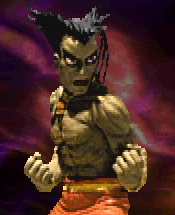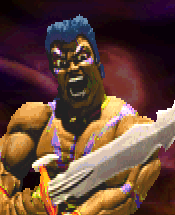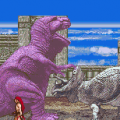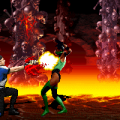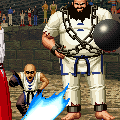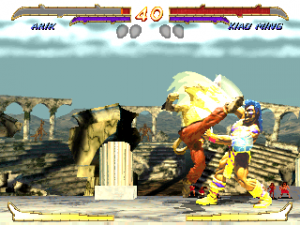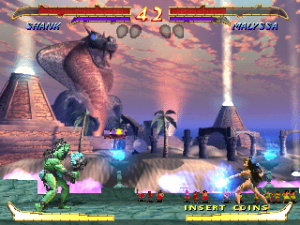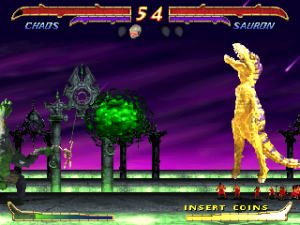- Primal Rage
- Primal Rage II
While it could never be as big as Mortal Kombat, Primal Rage managed to outdo just about every other MK competitor of the time. Perhaps it was the appeal of dinosaur combat, at a time when Jurassic Park was the coolest thing ever. Maybe it was the merchandising, made from characters that almost seemed like they were designed to be toys. It might have even been the multiple ports, meaning that nobody, not even the folks desperately clinging to the Amiga, could possibly escape the game. Whatever the reason, a sequel seemed inevitable.
Well, it did, before it got cancelled, for reasons nobody seems to be entirely clear on. The game was left unfinished, and was presumed lost. While the ROMs would eventually surface, no version of MAME put the game into a playable state. Some time later, an actual cabinet would eventually surface at Chicago’s Galloping Ghost Arcade, letting people experience the game for the first time. For those of us who weren’t local or lacked airfare, however, we had to make do with Youtube videos filmed by camcorder. Until recently, that is, when Gruntzilla94, someone who had been researching the game heavily, made a special version of MAME capable of fully running this mysterious game.
Since the game was never finished, any real faults of the game should be given with that in mind. While there’s plenty of glitches, unfinished animations, and things that are straight up broken, it should be assumed that all of these would have been fixed for release. Even if the game had come out, it’s likely there would have been further revisions, much like the original Rage. Still, considering its early state, it’s fairly playable, if not particularly amazing. Given the vast strides fighting games had made since 1994, PR2 had a lot more to go up against, and it can’t really compete.
It’s been some time since the events of the previous game, and the dino gods of Urth are still raging. Meanwhile, the humans have slowly began to form their own kingdoms, colonizing a new patch of Urth as their own. As it turns out however, one of the meteors that came along with the cataclysm that destroyed old Urth contained some sort of undead alien dragon named Necrosan. Necrosan is apparently just too hardcore for the gods to fight, so each of them picks a human to become their avatar to fight in their stead. Somehow, all the avatars beating on one another will eventually lead to Necrosan, in typical fighting game logic. From the start, you’re given the choice of eight different “Avatars” to play as, each of these being a human champion of each of the gods. Along with the original seven gods, a sabretooth tiger named Slashfang joins the rage, represented by martial artist Xiao Ming. By holding up for a few seconds over an Avatar, you can also select one of the gods themselves, doubling the roster. Furthermore, by holding up over a dino god, you’ll be given a special version of an Avatar that can switch forms at will, at the cost of no longer being able to use super moves. The small roster was one of the original game’s many issues, so it’s nice to see that particular issue had been dealt with.
Characters
Necrosan
While initially planned for another revision of the original game, Necrosan doesn’t make his appearance until the sequel. As the god of darkness, Necrosan hatched from one of the meteors that destroyed old Earth. Apparently, he wants to destroy the dino gods and hatch his alien spawn from the people of Urth, not having much motivation beyond that. He’s one of the few PR2 characters to get his own figure, probably because he’s got the most toyetic design of the entire cast.
Slashfang
As the god of the hunt, this smilodon apparently decided to sit out on the original bout of raging. He joins the sequel, which gives the game a little more mammalian representation nicely. He also makes a Shen Long reference, because that was the height of fighting game humor in the 90s.
Xiao Ming
As the avatar of Slashfang, Xiao Ming is the only avatar who doesn’t use a weapon, instead using his own fists and feets. He challenged Slashfang to a fight, lost, and now roams around Urth, trying to get Slashfang to fight him again. He also really, really likes his haircut, to the point where one of his ‘Extinctions’ has him giving it to his opponent.
Malyssa
As Vertigo’s avatar, Malyssa has apparently gotten her magical powers from allying with her. She also has a cool looking snake staff, which is about the most notable thing about her.
Arik
As Sauron’s avatar, it might be jumping the gun a little bit to say that Arik is basically KI2’s Tusk. Given that they’re both barbarian types with two-handed swords, a dragon punch, and a sword spinning move, it’s hard not to notice. As pretty much the closest thing PR2 has to a main character, Arik is a fallen prince who wants to kill Necrosan. Sauron thought that was pretty cool and gave him a big sword. The end.
Keena
As Talon’s avatar, the game makes it very clear that Keena is the youngest fighter in the game. Because of this, she considers the end of her training to kill Necrosan and rebuild her homeland. “Young” and “pretty” are pretty much her only real personality traits, but at least she has that “intenstine jumprope” fatality.
Shank
As the avatar of Chaos, Shank is also the product of his own genetic finagling. He goes out to kill Necrosan because he belives that his DNA will cure his genes. Much like Chaos, he’s also the game’s main source of toilet humor, farting to fly across the screen. This goes as far as to have him “finish” himself by sniffing one of his own farts. Thanks, Atari.
Sinjin
Serving as Diablo’s representative, Sinjin is apparently a guy who was immortal even before the cataclysm. Now he seeks to find a way to die. Not the most interesting concept for the guy who represents “Satan T-Rex”, sadly.
Kaze
Blizzard really liked his avatar, so he gave this samurai the ability to freeze people. To do this, however, Kaze has to perform a certain move that’ll buff a couple of his specials, the only character in the game who has to go through that kind of setup. He makes up for that by having some of the biggest combos in the game, however.
Tor
Despite the fact that the humans of Urth have rediscovered castles and samurai, Tor is the only Avatar who’s thought to wear armor. One of his win quotes, “Call me Alphonso Lodestone!”, almost certainly has to be a reference to something. To what, exactly, might be the newest biggest mystery in all of Primal Rage 2.
The game now uses a six button setup, with heavy attacks now being mapped to their own, separate button. Every character also now also has a super meter, which can be spent whenever it’s full to have your character morph into their alternate form and pull off an automatic combo. You’ll often use several of these per match, since the meter charges incredibly quickly. You can taunt for an instant full charge, eat the tiny humans running around for a charge, take damage, and even just spamming attacks builds meter, so there’s no need to try and save your meter at all. The nicest change, however, is that all special moves use simple, Street Fighter-style motions, instead of the needlessly complex and somewhat painful multi-button combinations of the original game.
All of this leads into a game that’s far more approachable than its predecessor ever was, so it’s easier to see what it does well. Just about everything combos from everything, from chains of basic moves, to stunning them with certain specials, and then going into a rage morph. Because of the moves are generally far simpler to perform, it’s a lot easier to pick just about any character and do decently well with them. Unfortunately, there’s not much in the way of real depth or advanced mechanics, meaning playing well depends on how often you can keep comboing your opponent. Some characters are better at this than others, especially Chaos, who can easily keep his opponent locked down with his fart projectile. It doesn’t help that the original game’s rudimentary infinite prevention hadn’t made it in at this point.
That’s not to say it still isn’t fun for a little while, however. The game’s focus on aggression keeps the pacing quick, and matches often end pretty quickly. It’s always satisfying to look for an opponent’s opening and pound on them with the best combo you can muster, and you’re given plenty of freedom to do that. If you want to play defensively, however, your only real option is to try and spam projectiles, since they typically have a hitbox just a little bigger than how they look on screen. If you’re playing against the AI, they’ll usually often than not have no idea how to deal with this, helping you get some easy early wins.
The single player will make you fight against all the Avatars, and then against all their gods, and the typically brutal ’90s fighting game’ AI means that reaching the end can take a while. Thankfully, this time around they’ve included a proper final boss with Necrosan, instead of the survival challenge of the previous game. While Necrosan has a design so goofy it wraps around to being cool again, that’s about all he has to set him apart from the regular cast. He even isn’t that much more difficult than the other fighters you’ve had to beat to get to this point, and while that’s still pretty difficult, it’s a little anticlimactic. Hopefully, one assumes, they would have at least give him an overdramatic death cutscene later on in development.
The fatalities, both found in game and within the data files, are generally far less gory, and most of them are pretty goofy. Even more so than the original game, which contained a finisher where the winning fighter performed a cannonball into a lake in the background. Somehow, this game manages to top that, with the goriest finisher being one where Keena uses her opponent’s intestines as a jumprope. Some characters also have ‘suicide’ finishers, which would have presumably been performed by the defeated character at the end of the match. Most of them are unfinished, the ones that aren’t are generally just very strange looking.
Generally, the new humans aren’t quite as interesting as the gods they represent, but not for lack of trying. Their stop-motion Claymation look gives them a distinctive look, and they all animate with a surprising amount of frames. They also have enough of their own goofy quirks to give them some much needed personality, like the way Xiao Ming will occasionally stop to fix his hair, just before collapsing in defeat. For better or worse, most of the over the top UI elements are gone. The status bars are much more plain, and rounds don’t get names like ‘First Blood’ and ‘Domination’. Minor touches, but ones that helped establish the game’s unusual setting nicely. Losing the original PR’s continue screen, where the digitized followers try desperately to revive the fallen god, is also a shame, although the goofy win quotes make up for it, somewhat.
Overall, while it’s great to finally get the chance to delve into this game and its mysteries, it’s difficult to give it a strong judgement. From what we’re able to see, it’s a fairly functional fighting game, and one that certainly seemed to fix the worst of the original game’s issues. However, in its current state, it doesn’t really offer much to compete against the multitude of other 2D fighters of the time, aside from its interesting visual style. That might well be the reason the game was never released, an unfortunate casualty of the deluge of fighting games in the 90s. At the very least, it’s definitely a game that’s been worth the wait to finally see what this goofy game actually was.
The game was never released, most likely because of the fact that without the dinos being the stars of the game, there wasn’t much separating it from Mortal Kombat and Killer Instinct. Necrosan and Slashfang were made into action figures along with the original seven, and the game’s plot was written into a book, Primal Rage: The Avatars. Copies are much expensive than they should be but there’s no doubt that it’s most likely profound, thought-provoking literature on the level of Twain himself.
After the sequel was cancelled, the stampede of hype behind Primal Rage dried up. There was plenty of merchandising, like action figures and board games, but in the minds of the game-playing public, the game seemed to never exist at all. Atari Games went on to make quite a few more games before being bought out by Midway, some of them good, like San Francisco Rush, and others not so good, like Mace: The Dark Age. It’s really a matter of personal opinion on whether Rage was a forgotten gem that was left behind in the fighter boom or a dated remnant of the 90s, but whichever it was… well, it sure as hell beat Bloodstorm any day.
Links
Primal Rage fansite features a movelist for PR2, and MAME4RAGE 2, the emulator needed to properly run the game.




